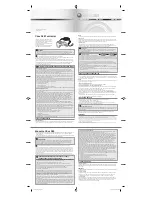
Note: Please note that the solar controller’s own consumption is higher with switched-on load output. (see technical
specifications)
Function of push button 1
When the device is in standby mode, you may activate the solar controller by pushing the button once, i.e. the device checks
both the input voltage of the solar module and the operating voltage.
When the device is activated, you may switch on the load output by pushing the button once.
Push the button again and the load output is switched off again.
Note: The standby function may be deactivated manually, but not activated!
Description of functions and safety features
Step-up function
The MPPT solar controller is equipped with a step-up function, i.e. the solar controller charges even if the solar voltage is lower
than the battery voltage. Here, the maximum charging current is 1A.
Note: Please note that this function is not given if the solar voltage is lower than the solar controller’s own consumption. In this
case, the solar controller switches to standby. (See explanation of standby function)
Standby function
When the solar charging power is lower than the solar controller’s own consumption, the standby function is automatically
activated after 30 seconds. This may also occur when the module is connected to the solar controller for the first time. When the
solar controller is in standby mode, all battery status LEDs (4, 5, 6) and the optional remote display are switched off.
Now the solar controller checks in intervals of 11 minutes whether sufficient solar power is available. If yes, the solar controller
switches to normal charging operation. Now one of the 3 battery status LEDs is on.
The standby function may also be deactivated manually by pushing button 1 once.
Deep discharge protection
The solar controllers of the MPPT series are equipped with deep discharge protection, i.e. with battery voltage decreasing to
10.5V, the solar controller switches the load off automatically. As soon as the battery is recharged over the solar module, the
load switches on automatically.
Overcharge protection
The MPPT solar controller stops the charging process reliably, when the final charging voltage is reached. This prevents the
battery from being damaged by overcharging or heavy steaming. The final charging voltage is factory-preset to 14.1V at 22°C.
Desulfation function (pulse charging)
Following the regular main charging phase, the solar controller applies pulses to the battery. This causes sulfate layers in the
battery to be dissolved which prolongs the battery lifetime significantly.
Temperature protective circuit
The MPPT solar controllers switch off the load current, when the temperature inside the device is too high. The load output
continues to function. When the solar controller has cooled down to normal operating temperature, charging current is
reconnected automatically.
Reverse polarity protection
The MPPT solar controllers are protected against incorrect connection to the battery. In case of incorrect connection to the
battery, the red LED7 is on. Ensure correct polarity when connecting (LED7 is off). The solar controller is reset automatically
and ready for use again.
Changing the internal fuse
The solar controllers of the MPPT series are equipped with an internal safety fuse. For changing the fuse, the housing of the
solar controller needs to be opened. For this purpose, disconnect the connected cables and the four screws on the side of the
housing. Now it is easy to remove the lid of the housing and you have free access to the fuse.
Attention: Replace the fuse only by a fuse of the same type and rated current!
Now close the housing of the solar controller.
Ensure that the external temperature sensor and its cable, as well as the cables of the LEDs are correctly placed in the lid and
that no cables are squeezed or damaged.
Operation with optional remote display
Optionally, all models of the MPPT solar controller series may be operated with a remote display.






































